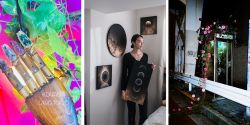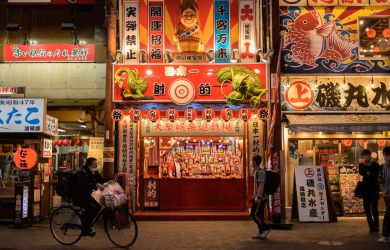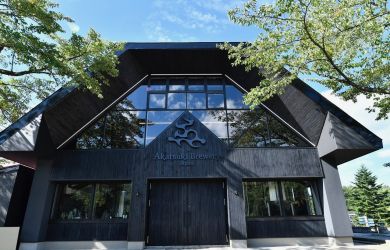
February 3, 2011
Kick Out the Drams
From Scottish Highlands to Kaku-highballs: the rise and rise of Japanese whisky
Originally published on metropolis.co.jp on February 2011

Photo by James Hadfield
Director: Mr Bob-san. [In Japanese] You’re relaxing in your study. There’s a bottle of Suntory whisky on the table. You understand, right? Say it with intense feeling, slowly, looking at the camera, tenderly, as if to an old friend. Like Bogie in Casablanca: “Here’s looking at you kid…” Suntory Time.
Interpreter: He wants you to turn, look in camera. OK?
Bob: That’s all he said?

Photo by James Hadfield
It was a drink with decades of history behind it. But until Bill Murray cradled a glass of Suntory Hibiki in Sofia Coppola’s Lost in Translation, most Westerners probably had no idea that Japanese whisky even existed.
The film’s release was well timed, in that respect. It hit screens in 2003, the year in which Suntory’s Yamazaki 12 Years Old became the first Japanese whisky to win a gold medal at the prestigious International Spirits Challenge (ISC) in London. Two years earlier, Whisky Magazine had proclaimed Nikka’s 10-year-old Yoichi the “best of the best.” Once all but unknown outside its domestic market, Japanese whisky was finally going places.
Since then, the accolades have been piling up. Suntory’s Hibiki 30 Years won the “Trophy,” the ISC’s highest prize, in 2004—and again in 2006, 2007 and 2008. Yamazaki 18 Years snagged the Double Gold Award at the San Francisco World Spirits Competition in 2005. In the 2008 World Whisky Awards, Japanese distilleries won in both the Best Single Malt and Best Blended categories. Suntory was named Distiller of the Year in the 2010 Icons of Whisky awards, and again in the ISC. I could go on, but it gets a bit repetitive.
“It’s exceptional to get a competition or an international tasting where a Japanese whisky doesn’t get a prize,” says Chris Bunting, a British journalist who’s become something of an authority on Japanese single malts. A favorable evening with a bottle of Yamazaki 12 Years led him to start the website Nonjatta in 2007, and it’s since become the go-to place for English information on Japanese distilleries, bars, booze shops and the whiskies themselves, free from PR puffery.

Courtesy of Suntory
“The reason why Japanese whisky has broken through was these competitions, but really the essential break had happened before that,” he says. Whereas big-name blended brands such as Johnnie Walker used to hold sway over global tastes, there’s been a general shift in preference towards single malts, with their emphasis on individual distilleries.
“You’re taking away some very vague branding [and moving] towards something more specific,” Bunting continues. “You’re empowering this sort of priesthood of critics, who smell it and taste it and say, ‘This is, in and of itself, excellent.’ And in doing that, you are actually internationalizing it, potentially. Because you are saying that some guy in Japan could, if he does it right, do it as well.”
And thankfully, some guys in Japan had been laying the necessary foundations. The story of Japanese whisky gets off to a hazy start in the early Meiji Era, but it doesn’t really pick up until 1923, when Suntory founder Shinjiro Torii established the country’s first commercial distillery in the Yamazaki Valley, not far from Kyoto. Torii hired one Masataka Taketsuru, the son of a nihonshu-making family, who had traveled to Scotland in 1918 in order to study at the University of Glasgow—and also learn about the art of distilling.
Returning to Japan with a Scottish wife in tow, Taketsuru became the first manager of the new Yamazaki Distillery, but his staunch allegiance to authentically smoky Scotch didn’t sit well with local tastes. He soon parted ways with his employers and went on to start Nikka in 1934, opening his first distillery in Yoichi, Hokkaido; the location reminded him of Scotland. Today, Suntory remains by far the largest whisky maker in Japan, with Nikka ranking second and Kirin a poor third.
Although Japanese distillers have to import most of their barley, they also enjoy certain perks that come with the terroir. Keita Minari, Global Brand Manager for Suntory Whisky, rattles off a list of these for me, ranging from the type of wood used in casks to the way that seasonal variations in temperature and humidity affect the maturation process.
There are other differences, too. While Scottish distilleries routinely trade casks with each other in order to influence the flavor of their blends, Suntory—by necessity as much as design—produces over 100 varieties of malt whisky itself. “If you can use very different types of whiskies in one bottle, that means the whisky is going to be very, very subtle,” explains Minari. “Subtle and delicate: that’s the uniqueness of Japanese whisky.”

Courtesy of Suntory
None of which explains why it took Japanese drinkers so long to fully embrace the drink produced in their own backyard. “Japan’s a funny market in some ways, because you often need to be told by the foreigner, from overseas, that your product is good before people actually really realize it,” says David Croll, a Tokyo-based whisky importer and distributor who also publishes the Japanese edition of Whisky Magazine. “But now I think Japanese have really caught on to the fact that what they have is fantastic, they’ve got a lot more confidence, and they’re really behind it in terms of marketing.”
One measure of this increased interest is the success of Whisky Live, the annual expo that Croll’s company organizes. First started in 2000 to mark the launch of the Japanese Whisky Magazine, the event has seen its attendance figures rise from 600 to 5,000, and spawned sister festivals from London to Taipei to Cape Town. This year’s Tokyo edition, held later this month, is expanding from one to two days for the first time, and moving from its previous home at Tokyo Big Sight in Odaiba to the classier environs of Roppongi’s Tokyo Midtown complex. (One rumored reason for the move is that the Scottish exhibitors couldn’t find any good bars to head to in Odaiba after the event was done.)
Another measure, of course, is the actual consumption of whisky in Japan, which in 2009 increased for the first time in 20 years. Mind you, that didn’t have as much to do with prize-winning prestige brands as it did with Suntory’s enormously successful campaign to promote whisky highballs as the izakaya tipple of choice. Though the company’s sales push has been focused on mass-market brands—first Kakubin, now the even cheaper Tory’s—it’s done a lot to help raise the profile of whisky in general.
“In the past, customers who preferred beer usually started off with one of those when they came in,” says Atsushi Horigami, the owner of Japanese whisky haven Shot Bar Zoetrope in Shinjuku. “Now, a lot of customers ask me to recommend a nice highball that isn’t too expensive instead.”
Horigami opened Zoetrope (pictured top) five years ago, leaving behind a career in video game production, and he’s well placed to observe recent trends in the market. In his eyes, one of the brightest stars at the moment is Ichiro Akuto, an independent distiller who’s in the process of resurrecting his family’s old whisky business.
The original Hanyu distillery closed in 2000 after its parent company went bankrupt, but Akuto was able to save its stocks, and is now reselling them under the Ichiro’s Malt label via his own company, Venture Whisky. In 2008, production commenced at a new distillery in Chichibu, Saitama Prefecture, and advance word has been very positive indeed.

Courtesy of Suntory
“Venture Whisky are distilling like crazy,” says Horigami. “They may be a small concern, but they’re actually producing the most out of anyone at the moment.”
“I think small producers will get a lot more attention in the future,” he predicts, also mentioning Eigashima’s White Oak distillery in Hyogo, and the surprise reopening of Hombo Spirits’ Mars Whisky distillery in Nagano. “I know that Suntory and Nikka aren’t going to stop, and they understand quality, so I think they’ll carry on making interesting products in the future too.”
On a more global level, Japan could face increased competition from countries that are nurturing whisky industries of their own, including South Africa, Taiwan and even India. But if its whiskies are unlikely ever to be the cheapest, there’s no arguing with their quality.
“I think Japan, long term, is really well-suited to becoming one of the major players,” says Croll. “It’s not going to have a hundred distilleries like Scotland, but I think it’s going to have a smaller number of very high quality distillers.”
And if the country’s whiskies are enjoying a particularly golden period at the moment, there’s no reason to assume that their luster will dim. “They are a bit like BMWs or Mercedes—there is some intrinsic quality to them,” says Bunting. “No doubt, they won’t be so fashionable in 20 years’ time, but they will still be very good.”
Whisky Live 2011
Whisky tastings, masterclasses and much more. Feb 19-20, 11am-6pm, ¥5,000 (one day)/¥9,000 (two days). Tokyo Midtown, Roppongi. Nearest stn: Roppongi. www.whiskymagjapan.com/live/2011
Detailed Japanese whisky news and reviews can be found at http://nonjatta.blogspot.com. Chris Bunting’s Drinking Japan will be released later in the year by Tuttle Publishing.
Shot Bar Zoetrope: 3F, 7-10-14 Nishi-Shinjuku. Tel: 03-3363-0162. Nearest stn: Nishi-Shinjuku or Shinjuku, west exit. Open Mon-Sat 7pm-4am, closed Sun & hols. http://homepage2.nifty.com/zoetrope
No whisky was consumed in the writing of this article.




-390x250.jpg)
